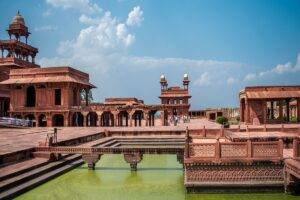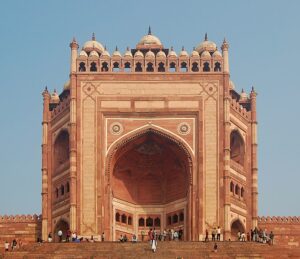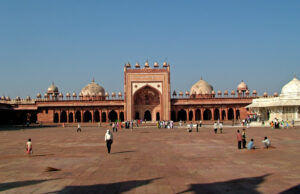Fatehpursikri agra: The Abandoned Mughal Marvel

Historical Background
Fatehpur Sikri was established by Emperor Akbar in 1571. The city was built on the site where the Sufi saint Sheikh Salim Chishti resided. Akbar, who had no heirs at the time, visited the saint to seek his blessings. When Akbar’s wife bore him a son, whom he named Salim (later known as Emperor Jahangir), Akbar attributed this miracle to Sheikh Salim Chishti’s blessing. In gratitude, he decided to build a grand city and move his capital from Agra to Fatehpur Sikri.
The city served as the capital of the Mughal Empire from 1571 to 1585. However, due to water scarcity and other logistical issues, it was abandoned as a capital and eventually fell into ruin. Despite its short-lived status as a capital, the architectural and cultural achievements of Fatehpur Sikri have left an indelible mark on Indian history.
Architectural Brilliance
Fatehpur Sikri is renowned for its impressive and harmonious blend of Persian, Indian, and Islamic architectural styles. The city is a sprawling complex of palaces, courtyards, mosques, and public buildings, all constructed with red sandstone, which gives it a distinctive appearance. Some of the most notable structures within Fatehpur Sikri include the Buland Darwaza, Jama Masjid, Panch Mahal, Diwan-i-Khas, Diwan-i-Aam, and the Tomb of Sheikh Salim Chishti.
Buland Darwaza:

Standing at a height of 54 meters, the Buland Darwaza is one of the tallest gateways in the world. It was built to commemorate Akbar’s victory over Gujarat and serves as the main entrance to the Jama Masjid. The gateway is an architectural marvel, with intricate carvings and inscriptions that showcase the artistic excellence of the Mughal era.
Jama Masjid:

The Jama Masjid is a grand mosque that stands at the heart of Fatehpur Sikri. It is one of the largest mosques in India and features a vast courtyard, elegant domes, and a beautifully decorated prayer hall. The mosque remains an active place of worship and a testament to the spiritual significance of the city.
Panch Mahal:

The Panch Mahal is a five-story pavilion that served as a pleasure palace for the royal family. Its unique design features diminishing floors supported by intricately carved pillars, creating a visually stunning and airy structure. The Panch Mahal offers panoramic views of the surrounding landscape and exemplifies the blend of Hindu and Mughal architectural styles.
Diwan-i-Khas and Diwan-i-Aam:

The Diwan-i-Khas (Hall of Private Audience) and Diwan-i-Aam (Hall of Public Audience) were central to the administrative and political activities of the Mughal court. The Diwan-i-Khas is particularly famous for its central pillar, which supports a platform where Akbar would hold private discussions with his advisors. The Diwan-i-Aam, on the other hand, was used for public audiences and state functions.
Tomb of Sheikh Salim Chishti: This white marble mausoleum is one of the most revered structures in Fatehpur Sikri. It houses the tomb of Sheikh Salim Chishti and is visited by pilgrims and tourists alike. The intricate marble lattice work (jalis) and the serene ambiance of the tomb make it a significant spiritual and architectural site.
Legacy and Preservation
Despite its abandonment, Fatehpur Sikri has remained a site of historical and architectural significance. The Archaeological Survey of India (ASI) has undertaken extensive efforts to preserve and restore the structures within the complex. Today, Fatehpur Sikri attracts thousands of visitors each year, offering them a glimpse into the grandeur of the Mughal Empire and the architectural genius of its creators.
Fatehpur Sikri’s legacy extends beyond its architectural brilliance. It stands as a symbol of the cultural and religious harmony that Akbar sought to promote during his reign. The city’s layout and design reflect his vision of a cosmopolitan and inclusive empire, where diverse traditions and beliefs could coexist.
In conclusion, Fatehpur Sikri is a remarkable monument that encapsulates the zenith of Mughal architectural and cultural achievements. Its grandeur, though short-lived, continues to inspire awe and admiration. As we explore its majestic ruins, we are reminded of the enduring legacy of Emperor Akbar and the timeless beauty of the Mughal era.
Leave a Reply